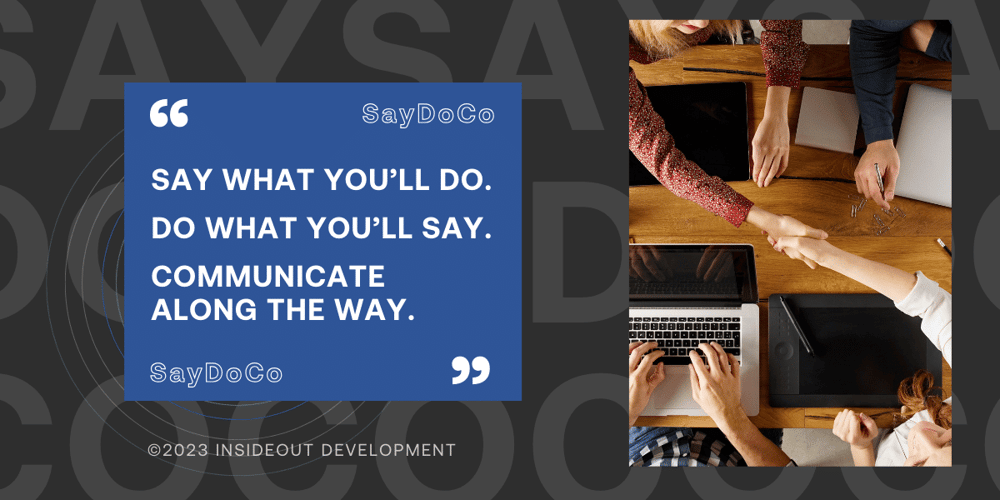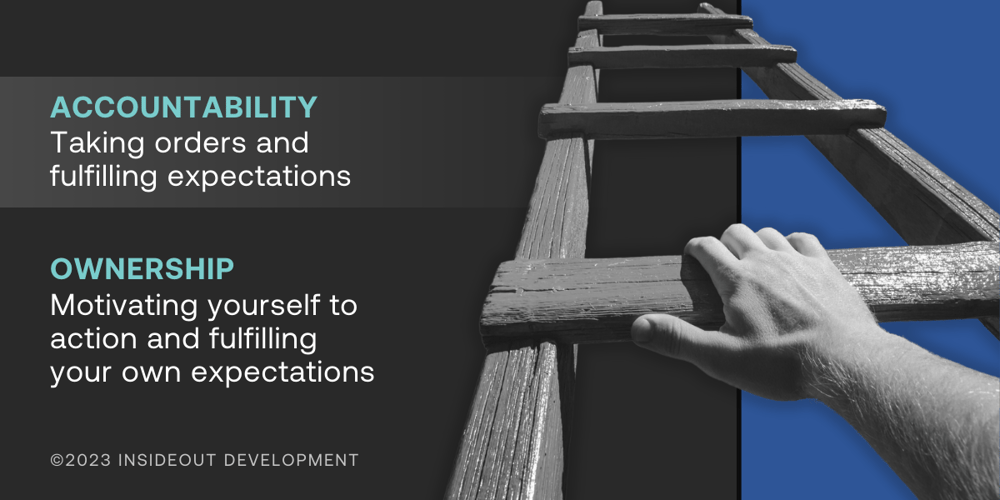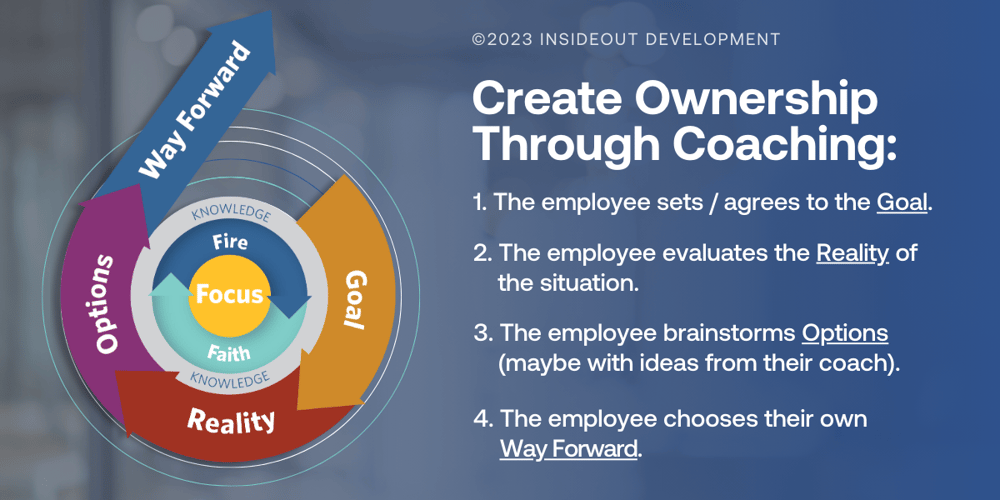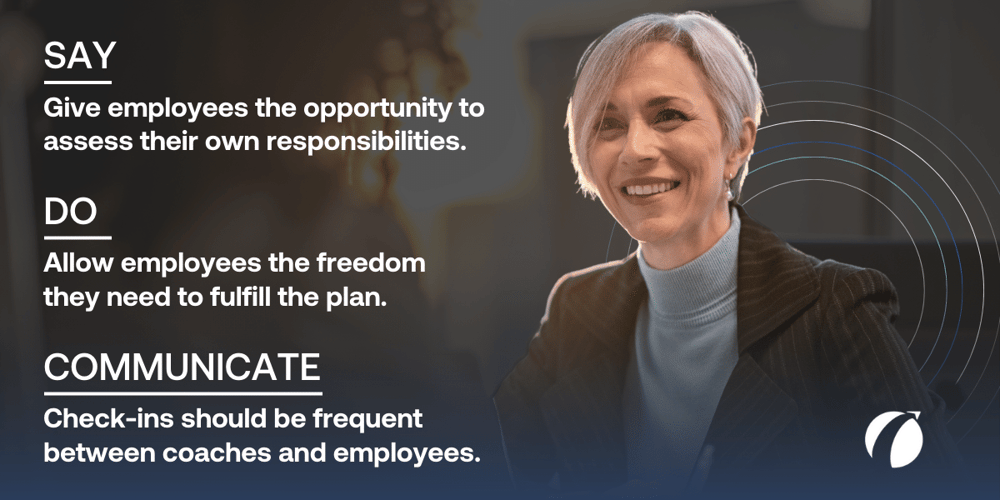“Say what you’ll do. Do what you’ll say. Communicate along the way.”
Beyond being a rather catchy phrase, this line — shortened to SayDoCo — is the philosophy behind ownership.
According to Alan Fine, founder of InsideOut Development, “SayDoCo transforms accountability into ownership. Accountability is doing what needs to be done because someone expects it of you. Ownership is doing what needs to be done because you expect it of yourself.”
Understanding Ownership vs Accountability
Ownership is often viewed as interchangeable with accountability. As shown in the quote above, the two terms are certainly related. But where accountability is about taking orders and fulfilling expectations, ownership is about motivating yourself to action and fulfilling your own expectations.
If we were to create a catchy phrase for accountability, it might be more along the lines of: “Get told what to do and do what you’re told.” This is both less catchy and far less exciting — not that there’s anything wrong with taking orders and fulfilling expectations. In fact, it’s a great place to start.
As a leader in your organization, you certainly don’t want to see people failing to be accountable. Accountability is good, but ownership is better.
Accountability leads to compliance. An accountable employee will deliver what is asked of them. Their monthly report will be accurate and punctual. Accountable employees know what is expected of them and they deliver on those expectations. Accountability ensures accuracy and consistency.
It’s an important first step, but an employee empowered with ownership takes things a step further. Ownership encourages employees to go above and beyond, develop better solutions, and contribute something of even greater value.
People are more committed to achieving plans they’ve had a hand in. Their Focus will be greater, they’ll have more Fire to succeed, and they’ll have greater Faith in their abilities to do so. This sort of commitment, this sort of passion, comes with ownership.
Building Organizational Ownership
You need to ask yourself if you are enabling a culture and attitude of ownership within your organization:
- Are you giving employees a say in how their work is completed?
- Are you encouraging and assisting employees to solve their own problems? Are you giving them the tools and autonomy needed to do so?
- Do you believe (and foster the belief in others) that the employees in your organization are capable and competent?
- Do you reward proactivity and innovation? Do you support and encourage attempts that are not initially successful?
At the core of these questions is a singular question of where the locus of control is within your organization. Does everything fall on the organization and senior leadership? Or do the individual employees within the organization take part in some of that control?
The more control individual employees have over their own area or responsibility, the more likely your organization has a culture of ownership.
Ownership doesn’t mean leaving your employees alone to figure out how to best navigate their individual situations. The best avenue for them to create these solutions is with someone who knows the direction the project and organization need to go.
Creating Ownership Through Coaching
Ownership isn’t really something we can give to our employees, but it is something we can develop and nurture through effective coaching.
Within your organization, you should have regular opportunities for employees and coaches to discuss together as a team what’s working, where things are getting stuck, and what could be done differently. While the coach will be the one to ask the questions, the coachee will be the one who really guides the conversation.
By following the GROW Model®, a coaching conversation passes through the four elements of any decision-making process in an order that makes the conversation more effective:
- The employee sets (or agrees to) the Goal.
- The employee evaluates the Reality of the situation.
- The employee brainstorms Options (perhaps with some ideas from their coach).
- The employee chooses their own Way Forward.
The coach plays the important role of making sure that organizational goals are still being pursued — and that an employee’s passion doesn’t pull them off track, a common interference that can hinder ownership. The coachee’s role is to use the conversation to determine solutions and figure out a path toward success.
Together, the coach and coachee determine the way forward that works both for the individual contributor and the organization as a whole. Because the employee has more ownership of the way forward, they are more committed to it because they are committed to the end result.
Using SayDoCo as a Metric for Ownership
SayDoCo helps to establish good habits within your organization to increase the positive effects of ownership. It also creates an understanding of how individual contributors within your organization need to handle their independence, both when plans are going right and when they hit a stumbling block.
It’s within coaching that SayDoCo really comes back into play in facilitating a culture of ownership.
Say
Give your employees the opportunity to assess their own responsibilities and create an action plan. Let them detail their plan — what they need support for, what they can do on their own, and in what order and in what way they want to tackle everything.
The coach’s job is to listen and, if necessary, point out possible pitfalls. The coachee, however, is responsible for saying what they are going to do.
Do
Allow your employees the freedom they need to fulfill the plan they presented when they were being coached.
Communicate
Check-ins should be a regular occurrence between coaches and employees. This should be an opportunity for coaches to ask what’s going right, where things are getting stuck, and how things might be done differently moving forward.
This is an opportunity for coachees to communicate where plans need to change or where they might need more support.
Accountability Matters, But Accountability + Ownership Is Better
You’ll be astonished by the benefits you’ll see when your organization develops a culture of ownership.
Your employees will bring their best to the table, accountability standards and metrics will be consistently met, creativity and innovation will increase, and your organization will see higher productivity — both as a whole and within units and individuals.
To learn more about how to foster ownership in your employees, check out A Framework for Building a Coaching Culture.





-03.jpg?width=322&name=Why%20Most%20Leadership%20Programs%20Do%20Not%20Work%20(And%20What%20to%20Do%20About%20It)-03.jpg)
